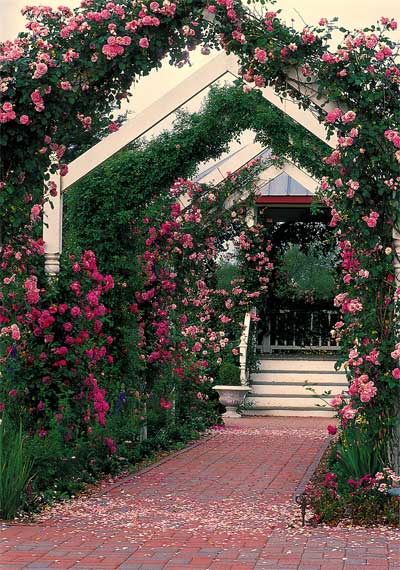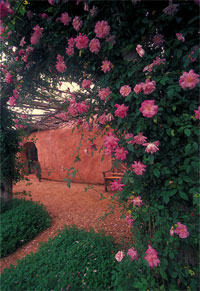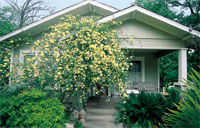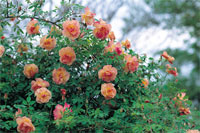Rose Cuttings – April, 2010

Several varieties of climbing roses cascade from the arches of an Antique Rose Emporium arbor. All photos courtesy of Mike Shoup.
From the Cold
The winter of 2009-2010, though colder than those of the past seven to 10 years, will go in the record books as actually being fairly average. The lows that we received in our area, 13 to 16 degrees Fahrenheit, are certainly within the normal range for average lows in Zone 8. However, the consistency and duration of cold that occurred, as opposed to the typical rollercoaster of warm and cold that we have come to expect during January and February, were somewhat unusual. As a result, we did have increased chilling hours that gave us some interesting results in our garden’s spring performance. Here are my observations:
Many established tender plants, those that have been in our landscape for the last 10 years, died this year. They included many varieties of citrus, palm, bottlebrush, bougainvillea, and dozens of tropical plants that in previous years escaped the killing freezes of a typical winter. On the other hand, fruit trees, Indian hawthorn, pyracantha and azaleas have been prolific in their flowering, with more flowers per square foot of plant than I have ever seen.
Roses were the champions of the garden this spring. The numerous flowers were also more colorful and individually larger than after prior winters. For some of our spring-blooming roses, this year’s winter was just what the gardener ordered. ‘Fortune’s Double Yellow,’ ‘Souvenir de Madame Leonie Viennot’ and ‘Belle of Portugal’ were as dramatic in the garden as the Lady Banks roses. When they were in bloom, the rarely seen expansiveness of flower productivity stopped people in their tracks.
These roses were joined by other spring bloomers like the R. wichuraiana hybrids, cousins of ‘New Dawn’, that also out-performed prior years’ displays. Notables were ‘Ghislane de Feligonde’, ‘Alberic Barbier’ and ‘Albertine.’

Climbing ‘Old Blush’
The repeat-blooming roses — the roses I consider the durable workhorses of the garden — which bloom consistently year after year, were also spectacular. ‘Old Blush,’ ‘Duchesse de Brabant’ and ‘Caldwell Pink’, instead of being stalwarts relegated to the background, were show-stoppers. Many of these roses had bigger blooms, making them look different from normal. They also had more intense colorations. They bloomed later than usual, creating combinations of plants that normally never bloom together. The “wow factor” was definitely in force this year. Our garden was as dreamy and dramatic as I have ever seen it.
I have learned that Mother Nature is never the same from year to year. Therein lies the beauty and intrigue for us gardeners. There will always be some unpredictability, whether it is in the sequence of bloom, the size and color of the flowers, or even whether or not a plant blooms at all. Nature is infinitely diverse in its revelation.
About the author: Mike Shoup is the owner of the Antique Rose Emporium. Visit his company’s Brenham and San Antonio display gardens for endless ideas on landscaping with roses. To order roses online, visit www.weAREroses.com.



